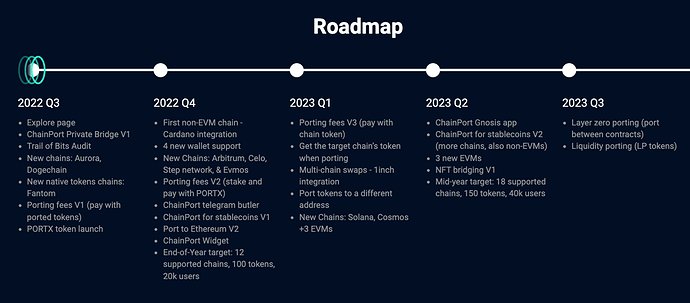Technical Grant Application - ChainPort
APPLICATION INTRODUCTION
ChainPort is a next-gen hard-security blockchain bridge that lets you hop across chains at a click. ChainPort employs full fund segragation, meaning contracts operating the bridge hold only an operating budget, and over 95% of funds are secured by MPC (Fireblocks) and/or Multi-Sig Vault Contracts (Gnosis). We support porting tokens to/from 13 of the most popular EVM chains as well as Cardano. ChainPort can help new users get into the Conflux ecosystem by providing cross chain support to/from other popular blockchains.
ChainPort also provides a custom custody solution allowing projects and/or DAOs to retain control over their liquidity, both the deposited frozen liquidity on source chains (i.e. act as required signatory on the MPC/Gnosis on source chain liquidity vaults), as well as retain manageability over target chains’ liquidity (i.e. being able to manage and apply security features to freeze token/addresses or upgrade tokens on the target chains).
TEAM
ChainPort is built and maintained by DcentraLab, you can meet our team on Linkedin
TOTAL BUDGET AND FUNDING TIER
Tier 2: $14k for setup and ongoing maintenance.
- Setup Conflux as target chain on ChainPort network - allowing projects originated on other chains to port to Conflux. ($6k) - timeline - up to 1 month.
- Setup Conflux as main chain on ChainPort network - allowing projects originated on Conflux to branch out to other chains. ($7k) - timeline - up to 1 months.
- Ongoing Maintenance, monitoring, management and support ($1k) - timeline - yearly ongoing.
CURRENT FUNCTIONALITY
ChainPort allows users to bridge tokens to/from 14 different blockchains at a click of a button. Most bridge transactions take less than two minutes. We also have several security features, automated monitoring tools and on-chain mechanisms to protect user funds from malicious actors. ChainPort employs full fund segregation, 95% of funds are stored in MPC and/or multi sig vaults.
TECHNICAL PROPOSAL
ChainPort will add the Conflux blockchain to its list of supported networks. Users will be able to:
- Port native Conflux tokens to other EVM chains
- Port tokens from EVM chains to Conflux
- We can also potentially open up Cardano ports for certain tokens by request
- We offer a fee-sharing model for projects that choose to use ChainPort. We also offer a fee-sharing model for organizations that refer us to projects.
Once Conflux is added to the list of supported networks at ChainPort, it will open up pathways for new users to enter the Conflux ecosystem.
SYSTEM MODEL
Glossary:
- Base-Chain/Source-Chain - The blockchain that the
Base-Tokenwas generated on. - Base-Token - ERC20 token that was created on EVM compatible blockchain:
- Deposit - Deposit
Base-TokenonBase-Chainbridge contract - Burn - Remove from circulation
Wrapped-Tokensby a transaction to theZero-Address. Used in:-
PortProcess -
RedeemProcess
-
- Release - Release
Base-TokenfromBase-Chainbridge contract. Used in:-
RedeemProcess
-
- Main-Chain - Refer to a deployed contract on a blockchain that gives that chain the ability to function as a
Source-Chain- deposit native tokens on that blockchain and port to other side chains. - Mint - Generate
Wrapped-Tokensas part ofPort - Native-Token - ERC20 token that was created on EVM compatible blockchain.
- Port - One use case of ChainPort, includes:
-
DepositBase-TokenonMain-ChainandMintWrapped-TokenonSide-Chain -
BurnWrapped-TokenonSide-ChainandMintWrapped-TokenonSide-Chain
-
- Redeem - One use case of ChainPort, includes:
-
BurnWrapped TokenonSide-ChainandReleaseBase-TokenonMain-Chain
-
- Wrapped Token - ChainPort’s version of the token that was generated as part of the porting process on another non-
Base-Chainblockchain:- For every
Wrapped-Tokenwe keep the reference to theBase-Token
- For every
- Zero-Address - The address token is sent as part of the
Burntransaction.
Use cases:
-
DepositTokens- ERC20 on source blockchain and receive wrapped token 1:1 on one the target blockchain
-
TokenTransfer- BurnWrapped-TokenonSide-Chainand move to one of the other supported blockchains. -
ReleaseTokens- BurnWrapped-TokenonTarget-Chainand release the original asset onSource-Chain
FrontEnd logic and BackEnd logic are decoupled
- Users can use most of ChainPort’s functionality by only on-chain actions.
DEVELOPMENT ROADMAP
- Support Stablecoin porting
- Support native Cardano tokens
- Add more EVM Chains
- Advanced stats and auto-arbitrage equalization cross-network
- ChainPort 2.0 - Generalized cross-chain messaging with decentralized security architecture
MAINTENANCE CONSIDERATIONS
Once Conflux is integrated into the ChainPort ecosystem, ongoing maintenance will be part of the operational budget, and is already worked into the grant request. Per usual. each blockchain required some amount (varying between blockchains) of ongoing management, related to optimizing RPC providers, maintaining nodes, maintaining the monitoring, alerts, backend and security operations related to the bridge functions on the specific blockchain.


